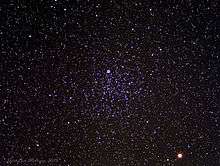Messier 46
Messier 46 or M46, also known as NGC 2437, is an open cluster of stars in the constellation of Puppis. It was discovered by Charles Messier in 1771. Dreyer described it as "very bright, very rich, very large." M46 is about 4,920 light-years away.[1] There are an estimated 500 stars in the cluster with a combined mass of 453 M☉,[2] and it is thought to be some 251.2 million years old.[1]
| Messier 46 | |
|---|---|
 | |
| Observation data (J2000.0 epoch) | |
| Constellation | Puppis |
| Right ascension | 07h 41m 46.0s[1] |
| Declination | −14° 48′ 36″[1] |
| Distance | 4.92 ± 0.98 kly (1.510 ± 0.302 kpc)[1] |
| Apparent magnitude (V) | 6.1 |
| Apparent dimensions (V) | 22.8′[2] |
| Physical characteristics | |
| Mass | 453+214 −145[2] M☉ |
| Radius | 37.8 ly[2] |
| Estimated age | 251.2[1] Myr |
| Notable features | contains superimposed planetary nebula NGC 2438 |
| Other designations | M64, NGC 2437, Cr 159, C 0739-147, OCl 601.0[3] |
The cluster has a tidal radius of 37.8 ± 4.6 ly (11.6 ± 1.4 pc) and a core radius of 8.5 ± 1.3 ly (2.6 ± 0.4 pc).[2] It has a greater spatial extend in the infrared than in visible light, suggesting that the cluster is undergoing some mass segregation with the fainter (redder) stars migrating to a coma region. The fainter stars that extend out to the south and west may form a tidal tail due to a past interaction.[4]
The planetary nebula NGC 2438 appears to lie within the cluster near its northern edge (the faint smudge at the top center of the image), but it is most likely unrelated since it does not share the cluster's radial velocity.[5][6] It is an example of a superimposed pair possibly similar to that of NGC 2818.[5][7] On the other hand, the illuminating star of the bipolar Calabash Nebula shares the radial velocity and proper motion of Messier 46, and is at the same distance, so is a bona fide member of the open cluster.[8]
M46 is located close by to another open cluster, Messier 47.[9] M46 is about a degree east of M47 in the sky, so the two fit well in a binocular or wide-angle telescope field.
See also
- List of Messier objects
References
- Wu, Zhen-Yu; et al. (November 2009), "The orbits of open clusters in the Galaxy", Monthly Notices of the Royal Astronomical Society, 399 (4): 2146–2164, arXiv:0909.3737, Bibcode:2009MNRAS.399.2146W, doi:10.1111/j.1365-2966.2009.15416.x.
- Piskunov, A. E.; et al. (June 2007), "Towards absolute scales for the radii and masses of open clusters", Astronomy and Astrophysics, 468 (1): 151–161, arXiv:astro-ph/0702517, Bibcode:2007A&A...468..151P, doi:10.1051/0004-6361:20077073.
- "M 46". SIMBAD. Centre de données astronomiques de Strasbourg. Retrieved 25 November 2018.
- Davidge, T. J. (February 2013), "The Open Cluster NGC 2437 (Messier 46)", Publications of the Astronomical Society of the Pacific, 125 (924): 115–125, arXiv:1301.6806, Bibcode:2013PASP..125..115D, doi:10.1086/669823
- Majaess, D. J.; Turner, D.; Lane, D. (2007). "In Search of Possible Associations between Planetary Nebulae and Open Clusters". Publications of the Astronomical Society of the Pacific. 119 (862): 1349. arXiv:0710.2900. Bibcode:2007PASP..119.1349M. doi:10.1086/524414.
- Kiss, L. L.; Szabó, Gy. M.; Balog, Z.; Parker, Q. A.; et al. (2008). "AAOmega radial velocities rule out current membership of the planetary nebula NGC 2438 in the open cluster M46". Monthly Notices of the Royal Astronomical Society. 391 (1): 399–404. arXiv:0809.0327. Bibcode:2008MNRAS.391..399K. doi:10.1111/j.1365-2966.2008.13899.x.
- Mermilliod, J.-C.; Clariá, J. J.; Andersen, J.; Piatti, A. E.; et al. (2001). "Red giants in open clusters. IX. NGC 2324, 2818, 3960 and 6259". Astronomy and Astrophysics. 375: 30–39. Bibcode:2001A&A...375...30M. CiteSeerX 10.1.1.30.7545. doi:10.1051/0004-6361:20010845.
- Vickers S.B.; Frew D.J.; Parker Q.A.; Bojicic I.S. (2015). "New light on Galactic post-asymptotic giant branch stars - I. First distance catalogue". Monthly Notices of the Royal Astronomical Society. 447 (2): 1673. arXiv:1403.7230. Bibcode:2015MNRAS.447.1673V. doi:10.1093/mnras/stu2383.
- "The hot blue stars of messier 47". ScienceDaily. 17 December 2014.
External links
| Wikimedia Commons has media related to Messier 46. |
- Messier 46, SEDS Messier pages
- Messier 46, Amateur Astronomer Image – Waid Obseratory
- Dark Atmospheres Photography – M46 w/ NGC 2438 detail
- NASA Astronomy Picture of the Day: M46 and NGC 2438: Young and Old (5 March 1999)
- NASA Astronomy Picture of the Day: Stars Young and Old (26 March 2009) - featuring M46
- NASA Astronomy Picture of the Day: M64 Plus Two (17 April 2015)
- Messier 46 on WikiSky: DSS2, SDSS, GALEX, IRAS, Hydrogen α, X-Ray, Astrophoto, Sky Map, Articles and images
